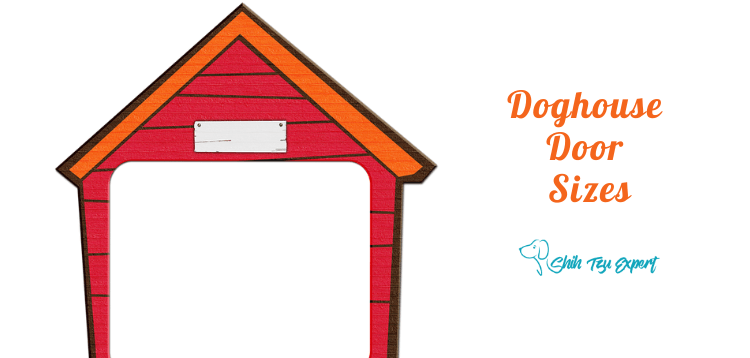
Owning a pet is no small task. Most dog owners consider their pup part of the family, and therefore do everything in their power to provide them with the most comfortable home possible. This includes the doghouse.
Whether your dog resides indoors or outdoors, it is common for owners to provide a doghouse in order for their pup to have a haven in which they can enjoy being outdoors. What many owners do not realize, however, is the importance of choosing the right size doghouse.
In order to choose the right size doghouse, the very first step is choosing the right size door. If your dog does not fit through the door, the rest of the house is useless. This is why properly sizing your doghouse door is so crucial, along with making the house itself the right size for your dog.

Importance of Size:
The size of the doghouse is crucial to the comfortability of the dog. It may not seem as important as you may think, but there are many elements that go into ensuring you have chosen the right house for your dog. The common rule of thumb is that a doghouse should have just enough room for the dog to go inside, turn around, and lie down. In this case, a little smaller is better. When dogs have a more snug, cozy fitting house, they will feel much more secure. This all begins with the door, which will be a deciding factor on whether or not the whole house is right for the dog. The door itself should be just big enough for the dog to get in easily, but not so big as to sacrifice the comfort of the dog when it’s in the house.
Importance of Weather
Knowing the Right Size
Like we mentioned before, it is so important to know the right size for your dog’s house. If the house is too small, your dog will not be able to comfortably enter and relax; if it is too large, your dog will not be able to stay warm and will feel unsafe. Choosing the right size of doghouse will ensure that your pup is comfortable. They will not only feel safe and secure, they will also be protected from the weather and any harsh outdoor elements. Two factors are taken into consideration when choosing the right doghouse and door: your dog’s weight and your dog’s measurements. Most often, owners use their dog’s weight to determine the proper doghouse size. While this is a good starting point, there are many factors that should be taken into account along with their weight. For example, you may have two dogs that weigh the same, however one may be a few inches shorter and stockier, while the other one is a few inches taller and lanky. These measurements are extremely important, because just a few inches difference in the dog’s height will change the proper height of your dog’s door and the interior measurements of the house.
Using Your Dog’s Measurements
How to Measure Your Dog
Now that you know the importance of measuring your dog to ensure the best size house for them, we will go through how to properly measure your dog. There is a total of four measurements that you should take of your dog. The first one is the total length of your dog. This is done by measuring your dog from the tip of their nose to the flank (the flank is the base of your dog’s tail). Be sure not to include the length of your dog’s tail in this measurement. The second measurement to take is your dog’s total height. This is done by measuring your dog from the base of its paws to the top of their head. The third measurement is your dog’s shoulder height. This is the measurement from the base of your dog’s paws to the front of their shoulder. This measurement is what you will use to determine the proper height and size of the doghouse door. Lastly, measure the width of your dog. This is done by measuring your dog at the widest point on its body. For most breeds, the widest point is between its front shoulders.

These measurements provide crucial information that you will use to determine the correct size of doghouse and door that you will need for your pup. As far as implementing these measurements to find the right size house, there are several different methods you may use. Each method provides a different recommendation for finding the proper dimensions of your doghouse, but each and every one uses the dimensions of your specific dog. We will look at four different methods – each one is similar in comparison to the rest, so you don’t have to worry too much about picking the right one. Just choose the one that seems like the best fit for yourself and for your dog.
The Asheville NC Humane Society Method
The first method comes from the Asheville, NC Humane Society. This humane society uses a pretty basic formula to determine the correct doghouse dimensions based on the dimensions of your dog. For the depth of the doghouse, they recommend taking your dog’s length and adding 12 inches to it. For the width of the doghouse, they recommend taking your dog’s length and this time adding 18 inches to it. Then, for the height of the doghouse, they use two different measurements – one for the low side of the roof, and one for the high side of the roof. For the low side, they recommend taking your dog’s height and adding 3 inches, and for the high side, taking your dog’s height and adding 9 inches. This is a very simple method which does not require a whole lot of calculating to determine the recommended dimensions. One downside to this method is that it is tailored to a specific type of doghouse – one that has a slanted roof. Since it is only applicable to this specific design, it is not as easy to use this method as a universal determinate for doghouse size. However, if you’re choosing this doghouse style and looking for a simple and easy way to find the best dimensions for your doghouse, this method is the way to go.
Ontario Humane Society Method
In contrast to the Asheville Humane Society’s method, this method is much more detailed when it comes to implementing your dog’s measurements. This method specifies the dimensions for the sleeping area, ceiling height, and doorway size. For the sleeping area, they recommend taking your dog’s shoulder height in inches (from the base of its paws to the top of its shoulders) and multiplying that by 36 inches. For example, if your dogs shoulder height is 12 inches, you would multiply it by 36 inches, which means the sleeping area of your doghouse should be 432 square inches of space. To determine the height of the ceiling, take your dog’s sitting position height in inches and add 2 inches to it. To measure your dog’s sitting height, measure from the base of its paws to the top of its head while seated. Lastly, this method provides dimensions for the doorway to your doghouse. For this, take the regular total height of your dog (from the base its paws to the top of its head while standing). As opposed to the standard ¾ rule for doghouse doors, they recommend making your dog door half of your dog’s height. Therefore, if your dog’s height is 20 inches, the door should be 10 inches. This method is interesting in that it provides a more mathematic approach to determining your doghouse size than the Asheville Humane Society, however it does pose a problem. This method promotes a very spacious doghouse, which is not ideal for those who live in colder climates. The formula this method uses to get to its dimensions provides a fairly large doghouse in comparison to your dog’s size. This can be really good for those who have dogs in warmer climates, but for those who have dogs living in colder climates, this is not the best option for you.
WOOD Magazine Method
The WOOD Magazine proposed its own formula in its 1995 issue for determining the best dimensions for your doghouse. This method, similar to that of the Ontario Humane Society, uses a mathematical formula to transfer your dog’s dimensions into its correlating house dimensions. This method employs three dimensions: depth, width, and height. For the depth of the doghouse, they recommend taking the length measurement of your dog (the tip of your dog’s nose to the flank – tail not included) and multiplying it by 1.5 times. For the width of the doghouse, take the same length measurement, but make the width only two thirds (2/3) of this measurement. Lastly, for the height of the doghouse, measure your dog’s height in a seated position (from the base of the paws to the top of their head) and multiply that amount by 1.5 times for the height of your doghouse. As opposed to the Ontario Humane Society method, which provides larger dimensions, this method instead provides much smaller dimensions. Therefore, the fit of the doghouses that use this formula will be much cozier and tight. This method is perfect for those who own dogs in much colder climates who need to ensure that their dogs are able to maintain their body heat and protect themselves from the cold.

The A-B-C Method
Lastly, the A-B-C method is the most widely used and accepted method for determining proper doghouse size. This method was developed by a cedar doghouse manufacturer. For this method there are three measurements of your dog that correlate to three dimensions of your doghouse. The first measurement, A, is your dog’s shoulder height (measured from the base of their paws to their shoulders). To determine the height of the doorway, this method recommends taking the A measurement and adding 1 inch to it. This is very similar to the common practice of making the doorway three fourths of your dog’s total height. Next, the B measurement is your dog’s length. It measures the total length from your dog’s nose to their flank (the base of their tail). This does not include your dog’s tail. Both the width and the depth of the doghouse should at least equal or slightly exceed the measurements for B. Lastly, the C measurement determines the total height of your dog. This measurement is taken from the base of your dog’s paws to the top of its head. This correlates to the height of the doghouse. According to this method, the recommendation is that the height of the doghouse should be the C measurement multiplied by 1.25 times. The appeal of this formula is that it is simple to use and easy to understand. The measurements of your dog correlate clearly to the measurements of the doghouse and can be used for a wide range of doghouse styles. It has also proved to produce the best fitting doghouse for all unique sizes since it takes into account the most important measurements of the dog.
Choosing the Right Method
Knowing Your Dog’s Size: Small and Extra Small Dogs
Now that we know how to properly measure our dogs using several different methods, it’s time to learn how to properly identify the correct size of your dog to ensure you are getting them the best suited doghouse. The first of these categories is the small and extra small dogs. These are dogs that weigh in at 25 pounds or less. Their shoulder height is 10 to 15 inches, while their total height (head to ground) is 12 to 16 inches. Their total length measurement from their nose to the base of their tail is 16 to 24 inches. A few examples of these breeds include Beagles, Chihuahuas, Cocker Spaniels, Yorkshire Terriers, and Pugs.
Knowing Your Dog’s Size: Medium and Intermediate Dogs
The next range is medium to intermediate sized dogs. This can be a pretty large category that encompasses many different breeds of dogs. The weight range for this category is 26 to 75 pounds. Their shoulder height is 15 to 25 inches, while their total height from the ground to the top of their head ranges from 20 to 30 inches. The total length of these dogs from their nose to the base of their tail is 25 to 35 inches. Breeds that are included in this category are Boxers, Springer Spaniels, Border Collies, and Bulldogs. Clearly, the height and weight differences between these breeds can be very vast. The height of the dog door for a Bulldog is not going to be the same as the height of the door for a Border Collie. This points again to just how vital it is that you take careful measurements of your dog in order to provide the proper house and doorway for their unique shape and size.
Knowing Your Dog’s Size: Large Dogs
Knowing Your Dog’s Size: Extra Large Dogs
The very last dog size category is extra large dogs. These are the dogs that weigh anything over 100 pounds. The shoulder height of these dogs is any measurement above 30 inches, and the total height from the ground to the top of their head is any measurement exceeding 38 inches. Their total length from their nose to the base of their tail is greater than 40 inches. Examples of these breeds include Great Danes, Great Pyrenees, Newfoundlands, and Saint Bernards. These are going to be your biggest breeds – therefore, if you have an extra large dog, make it a priority to thoroughly measure and invest in a doghouse big enough for them.
Do’s of Doghouse Doors
Now that all of the important bases have been covered, we will go over a few very important do’s and don’ts of doghouse doors. To start off, what you should do. Having an offset dog door on your house is extremely important. An offset door that is not centered on the middle of the doghouse will give your dog the right protection it needs. This offset acts as a windbreaker against cold weather and high winds. In the warmer months, it also gives your dog a cool spot to sit that is out of the sun. Your dog will be able to curl up in the corner opposite the door, allowing them to stay both warm or cool depending on its needs and the weather. Another helpful “do” when it comes to dog doors is having a protective barrier installed. This can be done using flexible plastic flaps (do not use cloth as it could get wet and moldy). Doing this is especially helpful during the cold winter months when your pet needs even more protection. Another helpful hint for choosing the very best doghouse is providing a porch or overhang on the front. This will allow your dog to have some extra coverage over the opening of the door, as well as give them a place to sit in the shade and out of the sun. This awning further protects your dog from severe weather by providing this extra covering.
Don’ts of Doghouse Doors
Now, what not to do when it comes to having the right doghouse door. The first don’t is that you should not get a doghouse with a door centered directly in the middle of the wall. Like we explained above, doors that are offset are ideal because they allow for much more protection from severe weather. In contrast, doors set in the center will expose your dog to the harsh elements outside, and not allow them to get out or protect themselves from direct sunlight. The next “don’t” of dog doors is that the door to the doghouse should never be closed during the hot months when heat is severe. If your doghouse has any type of swinging door or plastic covering that protects it from cold winds or severe winter weather, do NOT leave this on when the temperature starts to increase. You can fix this by either removing the door itself or tying it/propping it open. This will allow for greater ventilation, which will give your pet a cool haven out of the heat.

![Dog Door Installation [on Sliding Glass, Wood, Metal, etc ] Dog Door Installation [on Sliding Glass, Wood, Metal, etc ]](https://shihtzuexpert.com/wp-content/uploads/2020/06/Dog-Door-Installation.jpg)
![PetSafe Extreme Weather Door [Is this the best option for your Pup?] PetSafe Extreme Weather Door [Is this the best option for your Pup?]](https://shihtzuexpert.com/wp-content/uploads/2020/06/PetSafe-Extreme-Weather-Door-Specifications-and-Dimensions-.jpg)
![Best Energy Efficient Dog Door [Top Doggie doors in the market] Best Energy Efficient Dog Door [Top Doggie doors in the market]](https://shihtzuexpert.com/wp-content/uploads/2020/06/Best-Energy-Efficient-Dog-Door.png)
